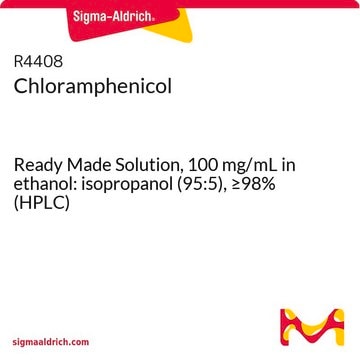C0857
Chloramphenicol
meets USP testing specifications
Synonym(e):
D(−)-threo-2,2-Dichlor-N-[β-hydroxy-α-(hydroxymethyl)-β-(4-nitrophenyl)-ethyl]-acetamid, D-(−)-threo-2-Dichloracetamido-1-(4-nitrophenyl)-1,3-propandiol, D-threo-2,2-Dichlor-N-[β-hydroxy-α-(hydroxymethyl)-4-nitrophenethyl]-acetamid, Chloromycetin
About This Item
Empfohlene Produkte
Agentur
USP/NF
meets USP testing specifications
Qualitätsniveau
Assay
97.0-103.0%
Form
crystalline
mp (Schmelzpunkt)
149-153 °C (lit.)
Löslichkeit
H2O: insoluble 100% (practically)
Wirkungsspektrum von Antibiotika
viruses
Anwendung(en)
pharmaceutical (small molecule)
Wirkungsweise
protein synthesis | interferes
Lagertemp.
2-8°C
SMILES String
OC[C@@H](NC(=O)C(Cl)Cl)[C@H](O)c1ccc(cc1)[N+]([O-])=O
InChI
1S/C11H12Cl2N2O5/c12-10(13)11(18)14-8(5-16)9(17)6-1-3-7(4-2-6)15(19)20/h1-4,8-10,16-17H,5H2,(H,14,18)/t8-,9-/m1/s1
InChIKey
WIIZWVCIJKGZOK-RKDXNWHRSA-N
Angaben zum Gen
human ... CYP1A2(1544)
Suchen Sie nach ähnlichen Produkten? Aufrufen Leitfaden zum Produktvergleich
Verwandte Kategorien
Allgemeine Beschreibung
Anwendung
Biochem./physiol. Wirkung
Resistenzmechanismus: Die Verwendung von Chloramphenicol-Acetyltransferase führt zur Acetylierung und Inaktivierung des Produkts.
Antimikrobielles Spektrum: Es handelt sich um ein Breitbandantibiotikum gegen grampositive und gramnegative Bakterien, das vor allem in der Augenheilkunde und in der Tiermedizin eingesetzt wird.
Vorsicht
Angaben zur Herstellung
Signalwort
Danger
H-Sätze
Gefahreneinstufungen
Carc. 2 - Eye Dam. 1 - Repr. 2
Lagerklassenschlüssel
11 - Combustible Solids
WGK
WGK 3
Persönliche Schutzausrüstung
Eyeshields, Gloves, type P3 (EN 143) respirator cartridges
Analysenzertifikate (COA)
Suchen Sie nach Analysenzertifikate (COA), indem Sie die Lot-/Chargennummer des Produkts eingeben. Lot- und Chargennummern sind auf dem Produktetikett hinter den Wörtern ‘Lot’ oder ‘Batch’ (Lot oder Charge) zu finden.
Besitzen Sie dieses Produkt bereits?
In der Dokumentenbibliothek finden Sie die Dokumentation zu den Produkten, die Sie kürzlich erworben haben.
Kunden haben sich ebenfalls angesehen
Unser Team von Wissenschaftlern verfügt über Erfahrung in allen Forschungsbereichen einschließlich Life Science, Materialwissenschaften, chemischer Synthese, Chromatographie, Analytik und vielen mehr..
Setzen Sie sich mit dem technischen Dienst in Verbindung.








